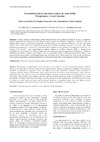Identificador persistente para citar o vincular este elemento:
https://accedacris.ulpgc.es/jspui/handle/10553/71093
| Campo DC | Valor | idioma |
|---|---|---|
| dc.contributor.author | Cabrera Vega, Laura Luisa | en_US |
| dc.contributor.author | Hernández Cordero, Antonio Ignacio | en_US |
| dc.contributor.author | Viera, M. | en_US |
| dc.contributor.author | Cruz, N. | en_US |
| dc.contributor.author | Hernández Calvento, Luis Francisco | en_US |
| dc.date.accessioned | 2020-03-27T11:17:44Z | - |
| dc.date.available | 2020-03-27T11:17:44Z | - |
| dc.date.issued | 2013 | en_US |
| dc.identifier.issn | 1576-5172 | en_US |
| dc.identifier.uri | https://accedacris.ulpgc.es/handle/10553/71093 | - |
| dc.description.abstract | La duna costera de Maspalomas, debido principalmente a las condiciones áridas en las que se desarrolla, presenta características diferentes de otras dunas costeras propias de ambientes templados y tropicales. Entre sus singularidades destaca la presencia de geoformas condicionadas por la vegetación, diferentes a las de otras dunas costeras: por un lado, dunas en montículo generadas por el arbusto Traganum moquinii; y por otro lado, dunas parabólicas generadas por la interacción de las dunas libres entrantes con las geoformas formadas por vegetación. Este estudio se ha llevado a cabo principalmente mediante análisis de ortofotos digitales, MDE y levantamientos topográficos, en el entorno de un SIG. La dinámica de los sedimentos desde la playa hacia el interior del sistema se caracteriza por diversos cambios morfológicos. Así, las geoformas eólicas evolucionan desde dunas libres, como pequeñas dunas transversales y morfologías barjanoides, en la playa alta, a dunas parabólicas. Una vez que la influencia de la vegetación desaparece, las dunas parabólicas evolucionan a dunas libres como barjanas o cordones barjanoides. | en_US |
| dc.description.abstract | The foredune of Maspalomas, mainly because it is developed in an arid environment, presents different characteristics from those located on temperate and tropical regions. Among its singularities highlights the presence of landforms conditioned by vegetation, which are different from other foredunes: hummock dunes generated by Traganum moquinii bushes; and parabolic dunes, generated by the interaction of the incoming free dunes with the hummock dunes. This study was carried out mainly by digital orthophotos analysis, DEM, and topographic survey, in a GIS context. The dynamic of the sediment from the beach to the inner part of the system is characterized by several morphological changes. Regarding this changes, from the backshore to the landward side, the landforms evolves from free dunes, as small transverse dunes and barchanoid landforms, to parabolic dunes. Once the influence of the vegetation disappears, the parabolic dunes evolve into free dunes as barchans or barchanoid ridges. | en_US |
| dc.language | spa | en_US |
| dc.relation | Consecuencias Ambientales Inducidas Por El Desarrollo Turistico en Espacios Insulares: Alteraciones de Los Procesos Naturales en Sistemas de Dunas Litorales de Canarias y Cabo Verde. | en_US |
| dc.relation | Diagnóstico Ambiental de Los Sistemas de Dunas de Canaris Para la Elaboración de Modelos Sostenibles | en_US |
| dc.relation.ispartof | Geotemas (Madrid) | en_US |
| dc.source | Geotemas (Madrid) [ISSN 1576-5172], n. 14, p. 107-110 | en_US |
| dc.subject | 250607 Geomorfología | en_US |
| dc.subject | 250507 Geografía física | en_US |
| dc.subject.other | Traganum moquinii | en_US |
| dc.subject.other | Tasas de avance | en_US |
| dc.subject.other | Geoforma | en_US |
| dc.subject.other | MDE | en_US |
| dc.subject.other | Topografía | en_US |
| dc.subject.other | Traganum moquinii | en_US |
| dc.subject.other | Migration rates | en_US |
| dc.subject.other | Landform | en_US |
| dc.subject.other | DEM | en_US |
| dc.subject.other | Topography | en_US |
| dc.title | Caracterización de una duna costera de zona árida: Maspalomas (Gran Canaria) | en_US |
| dc.title.alternative | Characterization of a foredune in an arid zone: Maspalomas (Gran Canaria) | en_US |
| dc.type | info:eu-repo/semantics/article | en_US |
| dc.type | Article | en_US |
| dc.relation.conference | VII Jornadas de Geomorfología Litoral | en_US |
| dc.investigacion | Artes y Humanidades | en_US |
| dc.type2 | Artículo | en_US |
| dc.utils.revision | Sí | en_US |
| dc.identifier.ulpgc | Sí | en_US |
| dc.contributor.buulpgc | BU-HUM | en_US |
| item.fulltext | Con texto completo | - |
| item.grantfulltext | open | - |
| crisitem.event.eventsstartdate | 17-07-2013 | - |
| crisitem.event.eventsenddate | 19-07-2013 | - |
| crisitem.author.dept | GIR IOCAG: Geografía, Medio Ambiente y Tecnologías de la Información Geográfica | - |
| crisitem.author.dept | IU de Oceanografía y Cambio Global | - |
| crisitem.author.dept | Departamento de Geografía | - |
| crisitem.author.dept | GIR IOCAG: Geografía, Medio Ambiente y Tecnologías de la Información Geográfica | - |
| crisitem.author.dept | IU de Oceanografía y Cambio Global | - |
| crisitem.author.dept | Departamento de Geografía | - |
| crisitem.author.orcid | 0000-0002-8373-9235 | - |
| crisitem.author.orcid | 0000-0002-4948-7230 | - |
| crisitem.author.parentorg | IU de Oceanografía y Cambio Global | - |
| crisitem.author.parentorg | IU de Oceanografía y Cambio Global | - |
| crisitem.author.fullName | Cabrera Vega, Laura Luisa | - |
| crisitem.author.fullName | Hernández Cordero, Antonio Ignacio | - |
| crisitem.author.fullName | Hernández Calvento, Luis Francisco | - |
| crisitem.project.principalinvestigator | Pérez-Chacón Espino, María Emma | - |
| crisitem.project.principalinvestigator | Hernández Calvento, Luis Francisco | - |
| Colección: | Artículos | |
Visitas
446
actualizado el 27-sep-2025
Descargas
329
actualizado el 27-sep-2025
Google ScholarTM
Verifica
Comparte
Exporta metadatos
Los elementos en ULPGC accedaCRIS están protegidos por derechos de autor con todos los derechos reservados, a menos que se indique lo contrario.
